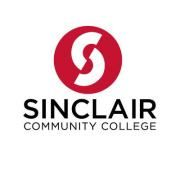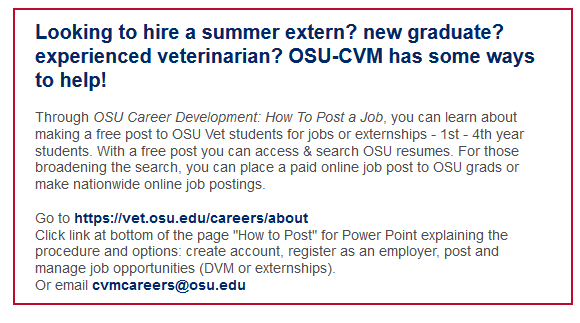 Veterinary Associations:
Veterinary Associations:
- Ohio Veterinary Medical Association OVMA: https://www.ohiovma.org/
- American Veterinary Medical Association AVMA: https://www.avma.org/
- Cincinnati Veterinary Medical Association CVMA: https://cincyvma.com/
Government Agencies
- Ohio Veterinary Medical Licensing Board: http://ovmlb.ohio.gov/
- Ohio Department of Agriculture: https://agri.ohio.gov/wps/portal/gov/oda/home/
- Ohio State Veterinarian: https://agri.ohio.gov/wps/portal/gov/oda/divisions/administration/divisions-leadership/person2
- Ohio Department of Natural Resources: https://ohiodnr.gov/wps/portal/gov/odnr-core/
- USDA-APHIS – Animal Health: https://www.aphis.usda.gov/aphis/home/
- USDA-APHIS, National Veterinary Accreditation Program: https://www.aphis.usda.gov/aphis/ourfocus/animalhealth/sa_vet_accreditation
USDA, APHIS, Veterinary Services:
Area Veterinarian-In-Charge:
USDA, APHIS, VS, 12927 Stonecreek Drive, Suite C, Pickerington, OH 43147-7001
Phone: 614.856-4735 / Fax: 614-866-1086
Veterinarian Continuing Education
- Care Center CE: https://carecentervets.com/veterinarians/
- Idexx Learning Center: https://www.idexxlearningcenter.com/
- MedVet CE: https://www.medvetforpets.com/sw-ohio-ce/
- The Ohio State University College of Veterinary Medicine Continuing Education, OSU-CVM CE: https://vet.osu.edu/alumni/continuing-education
Veterinarian and Veterinary Technician Education
- The Ohio State University College of Veterinary Medicine, OSU-CVM: https://vet.osu.edu/
- Sinclair Community College Veterinary Technology: https://www.sinclair.edu/academics/divisions/hs/vet/
- University of Cincinnati, Blue Ash College Veterinary Technology: https://www.ucblueash.edu/academics/departments/vet-tech.html
Humane Organizations:
- Animal Poison Control: https://www.aspca.org/pet-care/animal-poison-control
Sinclair Updates
Sinclair College will graduate 20 students this Spring, and while we are proud of these 20 graduates, we would love to train more!
Enrollment/Applications have dipped in the last couple of years and feedback from students gives us two things to tackle:
- Economic feasibility to work and go to school full-time
- Lack of benefit of a Veterinary Technician education when they are doing/being paid the same as a Veterinary Assistant.
The cost of a Veterinary Technician Education at Sinclair College ranges from $14,000 to $22,000 (depending on residency) for the 2+ year program – but with Financial Aid and Scholarships, over 1/3rd of students pays $0, and over 2/3rds have more than half of the fees covered without student debt. The program requires students to be on campus 2 days a week and to schedule an average of 14 hours/week at an assigned clinical site (unpaid). It is possible to hold a full-time position while attending school, but for best results, the faculty recommend students work 20 hours or less.
Registered Veterinary Technicians used properly in a practice can increase earning potential of that practice significantly. So how do you get more qualified veterinary technicians to apply to your practice?
- Protect the Registered Veterinary Technician title: incentivize educational advancement and licensure, title workers correctly on websites and job descriptions, educate the public on the differences in paraprofessional duties, responsibilities, and abilities.
- Consider mentoring a student through the clinical practicums of an accredited veterinary technology program – it is a terrific way to do a working interview AND train a potential employee to your clinic prior to hiring.
- Contribute to a scholarship program at the accredited veterinary program of your choice. Sinclair has two Foundation Scholarships that are designed to help veterinary technology students complete their programs as competent graduates. Click the link to find out more about Giving Opportunities at Sinclair. (https://www.sinclair.edu/giving/giving-opportunities/)
- Develop a program to grow your own veterinary technicians with a tuition reimbursement plan.
For our part, we are working to improve VTNE pass rates, developing plans to improve clinical opportunities in-house, added evening Introductory courses, and have developed a PART TIME CURRICULUM to cater to students who need to work, but would like to continue in the program.
Please reach out if you have questions or comments about this problem that affects all of us! vettech@sinclair.edu

